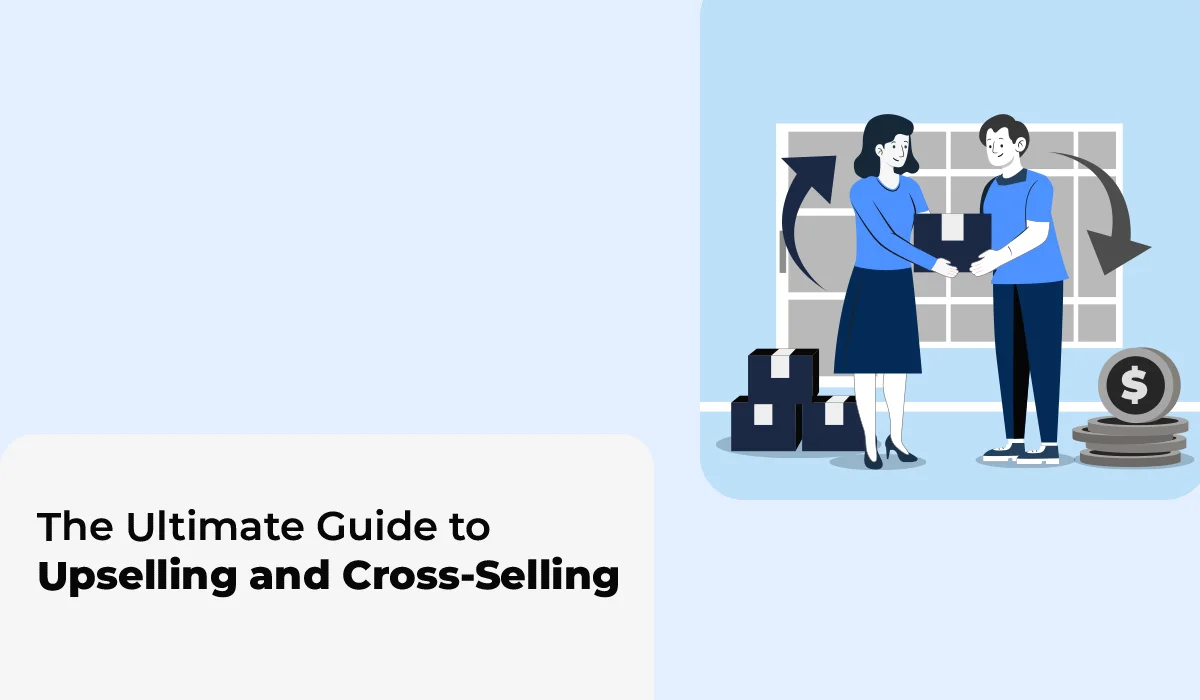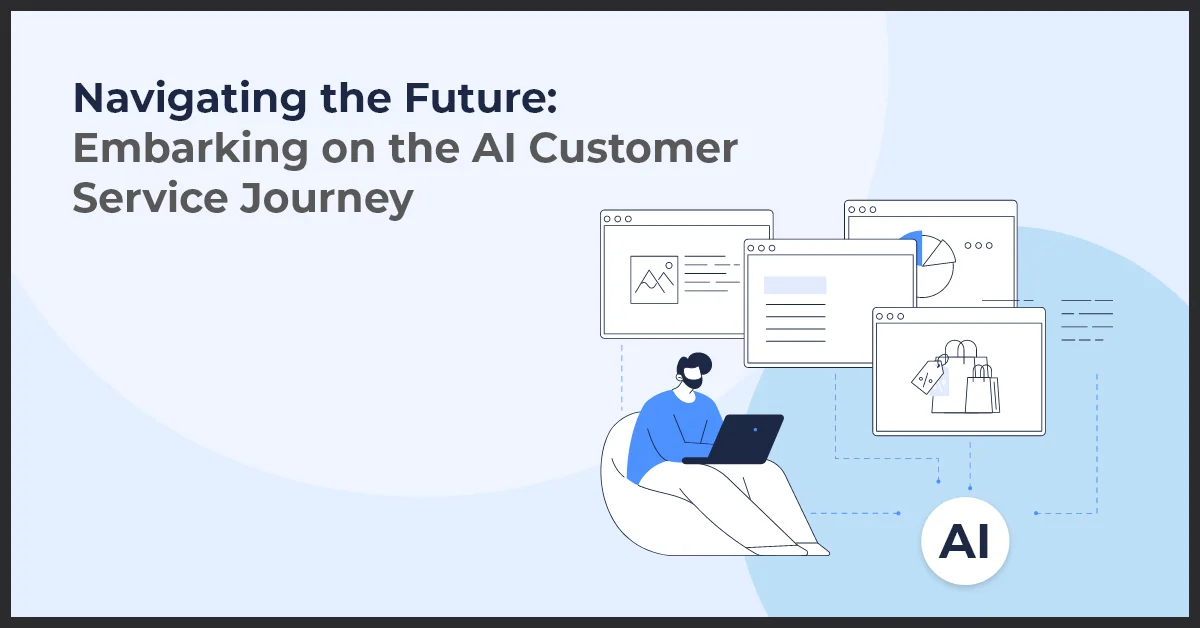The Ultimate Guide to Upselling and Cross-Selling

Published on: September 27, 2022
Updated on: July 12, 2024
997 Views
- Digital Marketing
13 min read
The Power of Upselling and Cross Selling: Boosting Revenue and Customer Satisfaction
As businesses strive to maximize their profits and enhance customer loyalty, the strategies of upselling and cross selling have emerged as game-changers. Implementing upselling techniques involves enticing customers to purchase a higher-priced product or upgrade, while cross selling involves suggesting complementary or additional items to what the customer has already chosen. In this comprehensive content, we will dive into the importance of upselling and cross selling, the immense benefits they bring to businesses, and provide you with an actionable plan to implement these strategies effectively.
Upselling and cross-selling make perfect sense at a time when businesses are staring at a possibility of an economic slowdown. These two sales techniques hold the potential to retain your existing customers and make them your brand advocates which eventually helps your business grow to newer heights—only if you know how to approach it well.
Let us look at some statistics:
- According to Marketo, 90% of customer value for B2B businesses is realized after the first sale.
- Today, companies such as Amazon make 35% of their revenue through upsells and cross-sells.
- Product recommendations account for an average of 10-30% of revenue on eCommerce sites.
Upselling and cross-selling can help you hit and possibly exceed your revenue goals.
So, what exactly are these two? How are they different? And how can you use them in your marketing strategy?
Read on to know.
Upsell Vs. Cross-Sell
Both upsell and cross-sell add new facets to the everyday phenomenon of selling. It is a fact that a customer's revenue possibilities continue even after the first point of sale. Also, these concepts are not altogether new as it has always been part of brick-and-mortar stores. What has changed is that the techniques have evolved with their adoption in the digital world.
Upselling
Upselling is a sales technique that involves encouraging customers to purchase a higher-end product or service or add-on to their existing purchase. It is a way for businesses to increase their average order value and ultimately boost revenue.
Definition and Explanation of Upselling
Upselling
Upselling is a sales technique where businesses offer customers a more expensive version of a product or service they are already considering purchasing. The goal is to convince customers to upgrade their purchase by highlighting the added features and benefits that come with the higher-tier option.
Upselling Strategies
1. Highlighting product/service features and benefits
One effective way to upsell is to showcase the unique features and benefits of the higher-tier options. Explain to your customers how these features can better meet their needs or provide them with additional value.
2. Offering higher-tier options or upgrades
Presenting customers with more premium or upgraded versions of the product or service they are interested in can entice them to spend more. Make sure to emphasize the added value they will receive by opting for the higher tiers.
3. Providing personalized recommendations based on customer preferences
By understanding your customers' preferences and purchase history, you can offer personalized recommendations that align with their interests. This targeted approach increases the likelihood of upselling successfully.
4. Using limited-time offers or promotions
Create a sense of urgency and exclusivity by offering limited-time promotions or discounts on the higher-tier options. This can motivate customers to make a purchase decision more quickly.
Cross Selling
A. Definition and Explanation of Cross Selling
Cross selling is a sales technique that involves offering additional products or services to a customer who is already making a purchase. It aims to increase the average order value and maximize revenue by encouraging customers to buy related or complementary items.
B. Cross Selling Techniques
- Creating bundles or packages of related products/services
One effective cross selling technique is to create bundles or packages of related products or services. By offering them at a discounted price compared to purchasing them individually, customers are more likely to see the value in buying multiple items together. - Recommending complementary items based on customer's purchase history
Another strategy is to recommend complementary items based on the customer's purchase history. Analyzing their past purchases allows you to understand their preferences and suggest items that they are likely to be interested in. - Leveraging cross-channel marketing to enhance cross-selling efforts
Utilizing various marketing channels, such as email, social media, or website banners, allows you to reach customers at different touchpoints throughout their buying journey. By showcasing related products or services, you can increase the chances of cross selling. - Utilizing CRM tools for effective cross-selling
Customer Relationship Management (CRM) tools can be used to track and analyze customer data, including purchase history and preferences. This information enables you to tailor cross-selling offers and effectively target customers with the right products or services.
Bundling: A Curated Upsell/Cross-Sell
A variation of upselling and cross-selling is bundling, where you provide a curated choice of products for your customers. This is often used by customers relying on you to simplify complex shopping decisions.
By pairing the main product with other essentials needed and providing a discount on this bundle, you raise the perceived value of your product.
6 Steps for a Successful Upsell and Cross-Sell
Below are the steps to follow when you upsell and cross-sell:
Establish Your Goals
Outlining your goals ensures that you are developing the right upsell and cross-sell strategy to achieve them. By mapping your goals for different stages of the revenue funnel, you can measure your impact along the way.
In case of none, you can use historical campaign data or build a baseline by focusing on conversion rates between revenue stages and potential sales scenarios and conversion. If you have a marketing automation platform, you can map your goals based on the customer revenue model, sales volume and speed, and the flow of customer leads.
Know Your Audience
For a successful cross-sell and upsell, go beyond buyer personas and gather more information about your audience once they buy your product. Collect customers' demographic and psychographic data and feedback to create Ideal Customer Profiles, identify their goals, and overcome obstacles in identifying the most relevant, pertinent products for an upsell and cross-sell.
Etch Out Customer Journeys
Customer journeys are essential to identify how your customers will use your products and anticipate their needs. Below are the different stages of consideration.
Enablement: Here, you work to meet your customer's expectations from your product and deliver a great customer experience. It includes post-sale onboarding and enablement services. Give your customers enough time to know your product before sending them other opportunities.
Adoption/Retention: This stage is essential to identify both cross-sell and upsell opportunities because your objective in this stage is to increase adoption and customer retention. When your product adoption increases, your customers realize your product value, and you establish the much-needed trust.
Growth: This stage is where you make the cross-sell/upsell pitch and compel your customers to increase their investment in your business. It allows you to optimize your cross-sell strategies while growing simultaneously.
Advocacy: The chatter around your product will increase once your customers see the
results and trust your brand. They will tell others about it and increase referrals. According to the Edelman Trust Barometer, 84% of B2B businesses start the buying process with a referral.
Segment Your Customer Base
Segmenting the customer base is critical at this stage of expanding your cross-sell and upsell strategy. Identify the most significant, most profitable segments and simultaneously delve further into the smallest and least profitable customers who demand a lot of effort and resources.
Once done, create a strategy for cross-selling and upselling that will work for each of these segments and existing ones, such as demographics, firmographics, geographic and behavioral, product ownership, usage, and product interest.
Provide Solutions Mapped to Products
After defining your marketing segments:
- Map them to your existing products and services.
- Look for products or solutions your customers already have and identify products that can further solve their needs.
In other words, identify opportunities where this gap exists.
Based on this approach, you can provide new perspectives to your sales team, so they know how to approach each account uniquely. This will help integrate cross-sell and upsell campaigns into your marketing approach.
Develop Your Program
The final step is where you decide your marketing tactics. The optimal approach would be to use various programs to engage customers across different channels. Reach out to your existing customers while saving on pricey acquisition programs. If unsure what would work, you can always test it out through email, webinars, and live events and go from there. This would help optimize and scale your marketing campaigns.
Combining Upselling and Cross Selling
Combining upselling and cross selling techniques can significantly boost your business revenue and enhance the overall customer experience. By understanding the synergy between these two strategies and implementing effective strategies, you can maximize sales opportunities and increase customer satisfaction.
A. The synergy between upselling and cross selling
Upselling and cross selling are both powerful sales techniques that work together to increase the average order value and maximize sales revenue. While upselling involves persuading customers to purchase a more expensive version or upgrade of a product or service, cross selling involves offering complementary or related products to the customer.
When used together, these techniques can create a win-win situation for both the business and the customer. The customer receives a personalized shopping experience and discovers products that enhance their original purchase, while the business generates additional revenue by increasing the customer's order value.
B. Strategies for combining both techniques
1. Identifying opportunities to upsell during cross-selling interactions
During cross-selling interactions, take advantage of the customer's interest in related products to suggest an upsell. For example, if a customer is purchasing a camera, you could recommend a higher-end model with additional features or accessories.
2. Using personalized recommendations for cross-selling and upselling
Utilize customer data and preferences to offer personalized recommendations for cross-selling and upselling. By understanding the customer's past purchases and browsing behavior, you can suggest products that are relevant to their interests and needs.
3. Utilizing customer segmentation to tailor cross-selling and upselling offers
Segment your customer base and create targeted offers for each segment. By understanding your customers' demographics, preferences, and buying behavior, you can customize your cross-selling and upselling offers to meet their specific needs and preferences.
4. Ensuring exceptional customer service throughout the process
Excellent customer service is crucial when combining upselling and cross selling techniques. Ensure that your sales representatives are knowledgeable about the products and can provide helpful recommendations without being pushy. Focus on building trust and delivering value to the customer.
5. Best Practices for Successful Upselling and Cross Selling
- Clearly communicate the benefits of the upsell or cross-sell to the customer.
- Offer discounts or special promotions for bundled purchases.
- Monitor customer feedback and adjust your upselling and cross-selling strategies accordingly.
- Continuously train your sales team on effective upselling and cross-selling techniques.
By following these best practices, you can optimize your upselling and cross-selling efforts and achieve successful results.
Tips and Best Practices
Cross-selling and upselling are not your usual sales pitch. It is not one-size-fits-all, as every customer has a different need. These tips below, however, can help you standardize to some extent, your cross-sell/upsell strategy:
Maintain a Price Range
For any proposed upsell and cross-sell, ensure a price range with purchase potential. Ideally, it should not exceed 50% of your customer's original buy. Anything higher and the likelihood of conversion reduces significantly.
Make It Easy
The first mantra for a good sale is convenience. Always make it easy for customers to upgrade or include add-ons while shopping. Top it with relevant choices, and your customers will follow through.
Offer Bundles
Bundles are effective for cross-selling and upselling when created strategically. Ecommerce websites provide specific plugins that make bundling easy. For instance, Shopify's Bold Bundles make it easy to customize for each customer.
Make Recommendations
The rolling ticker of products, beneath the main product that your customer browses, is a peek into your online store. It is also a savvy way of making recommendations while showing what other customers bought, similar to your customer's object of interest.
Provide a Choice
Combining upselling and cross-selling works best as it provides multiple offers to your clients. For example, you could upsell one thing on the product page and then cross-sell another on the cart page. Sometimes, you can use the "rule of three" that, according to research, prompts better customer response.
Offer Incentives
Apart from making upselling/cross-selling easy and accessible, it would help if you also incentivized these additional purchases. It can be something as simple as free shipping. You can add freebies to their existing subscription services if you sell a service.
Leverage Social Proof
The market is another place where your customers constantly seek validation. Social proof or online reviews provide exactly that and eases purchase decisions. Successful businesses like Amazon leverage it on every page, which makes it easier to cross-sell/upsell to their customers.
Deploy Decoy Effect
Your customers expect transparency about the product when you upsell. This must include the product features, pricing breakdown, and other available options. It may not always play in your favor; that is why a lot of businesses deploy what is called a decoy effect. This strategy makes your customer switch from one product to another pricier option by introducing a third, less attractive option that alters their perception of the original two choices.
Conclusion
By following the best practices outlined in this guide, businesses can effectively utilize upselling and cross-selling techniques to enhance their revenue generation.
Implementing upselling and cross-selling strategies can be a game-changer for businesses. Not only do these techniques generate additional revenue, but they also help strengthen customer relationships through personalized recommendations and improved customer experiences.
Getting cross-selling and upselling right takes a lot of tact, perfect timing, acute awareness, and empathy for your customers. A lot of things need to be done right to ensure that it works. You need to know how your customer feels, the kind of features or products they would find helpful, and when and where they will be most open to an additional offer. Only then will you be able to cross-sell and upsell to them.
Growth Natives are here to help you develop your successful cross-sell and upsell strategy. Write to us at info@growthnatives.com to shoot your queries or know more.



